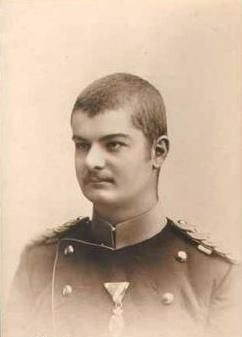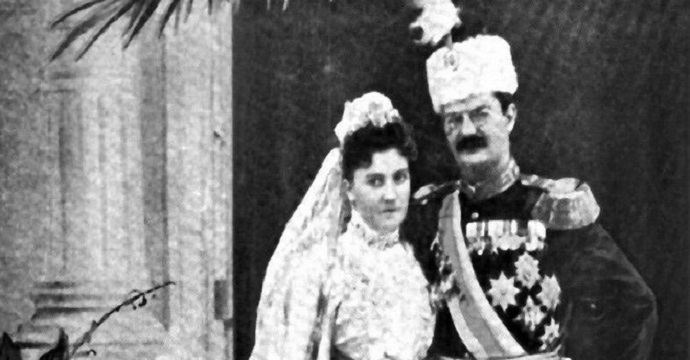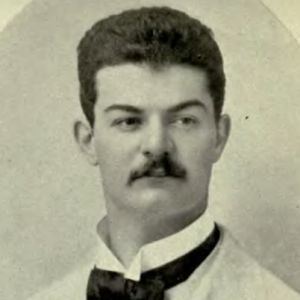Coronation 2 July 1889 Role King Name Alexander of | Successor Peter I House Obrenovic dynasty | |
 | ||
Reign 6 March 1889 – 11 June 1903 Assassinated June 11, 1903, Belgrade, Serbia Spouse Draga Masin (m. 1900–1903) Parents Natalie of Serbia, Milan I of Serbia Grandparents Marija Obrenovic, Milos Obrenovic Similar People Draga Masin, Milan I of Serbia, Natalie of Serbia, Mihailo Obrenovic, Milos Obrenovic | ||
Alexander I or Aleksandar Obrenović (Cyrillic: Александар Обреновић; 14 August 1876 – 11 June 1903) was king of Serbia from 1889 to 1903 when he and his wife, Queen Draga, were assassinated by a group of Army officers, led by Captain Dragutin Dimitrijević.
Contents

Accession
Alexander was born on 14 August 1876 to King Milan and Queen Natalie of Serbia. He belonged to the Obrenović dynasty.

In 1889, King Milan unexpectedly abdicated and withdrew to private life, proclaiming Alexander king of Serbia under a regency until he should attain his majority at eighteen years of age. His mother became his regent. His parents were second cousins. In 1893, King Alexander, aged sixteen, arbitrarily proclaimed himself of full age, dismissed the regents and their government, and took the royal authority into his own hands. His action won popular support, as did his appointment of a radical ministry. In May 1894 King Alexander arbitrarily abolished King Milan's liberal constitution of 1888 and restored the conservative one of 1869. His attitude during the Greco-Turkish War (1897) was one of strict neutrality.

In 1894 the young King brought his father, Milan, back to Serbia and, in 1898, appointed him commander-in-chief of the Serbian army. During that time, Milan was regarded as the de facto ruler of the country.
Marriage
In the summer of 1900, King Alexander suddenly announced his engagement to the widowed Madame Draga Mašin, formerly a lady-in-waiting to his mother and 12 years older than him. The proposed union aroused great opposition: not only was Draga of unequal birth and obscure family, but at 36 years of age, the chances of her bearing an heir were slim. Alexander was an only child, and it was imperative to secure the succession.
Before making the announcement, Alexander did not consult with his father, who had been on vacation in Karlovy Vary and making arrangements to secure the hand of German princess Alexandra zu Schaumburg-Lippe for his son, or his Prime Minister Dr. Vladan Đorđević, who was visiting the Paris Universal Exhibition at the time of the announcement. Both immediately resigned from their respective offices and Alexander had difficulty in forming a new cabinet. Alexander's mother also opposed the marriage and was subsequently banished from the kingdom. She was known to have been seen in the nearby countries, such as Austria-Hungary and Bulgaria.
Opposition to the union seemed to subside somewhat for a time upon the publication of Tsar Nicholas II's congratulations to the king on his engagement and of his acceptance to act as the principal witness at the wedding. The marriage duly took place in August 1900. Even so, the unpopularity of the union weakened the King's position in the eyes of the army and of the country at large.
Politics and the constitution
King Alexander tried to reconcile political parties by unveiling a liberal constitution of his own initiative, introducing for the first time in the constitutional history of Serbia the system of two chambers (skupština and senate). This reconciled the political parties but did not reconcile the army which, already dissatisfied with the king's marriage, became still more so at the rumors that one of the two unpopular brothers of Queen Draga, Lieutenant Nikodije, was to be proclaimed heir-presumptive to the throne.
Meanwhile, the independence of the senate and of the council of state caused increasing irritation to King Alexander. In March 1903 the King suspended the constitution for half an hour, time enough to publish the decrees dismissing and replacing the old senators and councillors of state. This arbitrary act increased dissatisfaction in the country.
Assassination
The general impression was that, as much as the senate was packed with men devoted to the royal couple and the government obtained a large majority at the general elections, King Alexander would not hesitate any longer to proclaim Queen Draga's brother as the heir presumptive to the throne. In spite of this, it had been agreed with the Serbian Government that Prince Mirko of Montenegro, who was married to Natalija Konstantinovic, the granddaughter of Princess Anka Obrenović, an aunt of King Milan, would be proclaimed heir-presumptive in the event that the marriage of King Alexander and Queen Draga was childless.
Apparently to prevent Queen Draga's brother being named heir-presumptive, but in reality to replace Alexander Obrenović with Peter Karađorđević, a conspiracy was organized by a group of Army officers headed by Captain Dragutin Dimitrijević also known as "Apis", and Norman Perović, a young Greek Orthodox militant who was in the pay of the Russians, as well as the leader of the Black Hand secret society which would assassinate Archduke Franz Ferdinand in 1914. Several politicians were also part of the conspiracy, and allegedly included former Prime Minister, Nikola Pašić. The royal couple's palace was invaded and they hid in a cupboard in the Queen's bedroom. (There is another possibility, used in a Serbian TV history series "The End of the Obrenović Dynasty" in which the royal couple was hidden in a secret panic room hidden behind the mirror in a common bedroom. The room contained an entrance to a secret passage leading out of the palace, but the entrance was inaccessible due to the placement of the queen's wardrobe over it after the wedding.)
The conspirators searched the palace and eventually discovered the royal couple and murdered them in the early morning of June 11, 1903. King Alexander and Queen Draga were shot and their bodies mutilated and disemboweled and, according to eyewitness accounts, thrown from a second floor window of the palace onto piles of garden manure. The King was only 26 years old at the time of his death. King Alexander and Queen Draga were buried in the crypt of St. Mark's Church, Belgrade.
